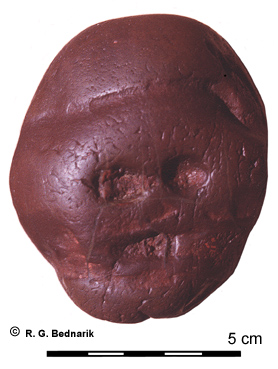Manuports and very early palaeoart
 The Makapansgat jasperite cobble, <3 million years, South Africa.
|
Manuports are unmodified objects transported and deposited by hominids, and they are distinguished by being of a usually striking material clearly foreign to the sediment containing the occupation deposit they occur in. Indeed, there is one singular instance of a manuport suggested to have been deposited by a pre-human, the Makapansgat cobble (Bednarik 1998b). Although the involvement of an australopithecine has been favoured in the past, that of a very early and as yet unknown hominid cannot be excluded. The age of its sediment, the level 3 pink stony bone breccia (Partridge’s Member 4; cf. Oakley 1981: 205), is between two and three million years, and closer to the higher figure (McFadden et al. 1979). While this is beyond the widely accepted chronological range of Homo, the discovery of Kenyanthropus platyops offers an alternative attribution of the cobble. The former dolerite cave of Makapansgat, South Africa, contained substantial deposits of australopithecine-bearing breccia, and it was among these remains that a jasperite cobble was excavated in 1925, which had been carried to the site over a distance of at least several kilometres. The red-coloured cobble bears such striking markings that archaeologists have suggested they might have been made, or at least emphasised, artificially (see figure above). Yet for 72 years it was never subjected to analysis, until in 1997 detailed microscopic analysis established that its various markings are all entirely natural (Bednarik 1998b, 1999a). Nevertheless, it was carried into the cave either by Australopithecus africanus, or by an as yet unknown hominid. Almost certainly this was because of its conspicuous colour, shape and markings — most especially the ‘staring eyes motif’ formed by two equal-sized, symmetrically located depressions iconographically related to a mouth-like marking.
While this find does not necessarily imply iconographic comprehension (the ‘staring eyes’ motif can be detected even by birds and insects) it does demonstrate that such an object has attracted sufficient curiosity to have been carried around for some time. This manuport qualifies as palaeoart in the sense that it conveyed non-inherent properties to its collectors that were imposed by neural processes and involved an incipient form of consciousness.
The Makapansgat cobble is the oldest known object of this kind in the world, and for more than one half of the duration of human history it remains alone on our extremely fragmentary archaeological record. Perhaps a million years BP Homo erectus took to the sea, no doubt progressively venturing out further and further, until by about 850 ka ago he managed to cross several stretches of sea to colonise first the Indonesian island of Flores, and subsequently Timor (Bednarik 1999b; Bednarik and Kuckenburg 1999). This point in time seems significant, because it is also between 800 and 900 ka ago that the first use of pigment becomes detectable (in South Africa and perhaps India), and around the same time the practice of collecting crystal prisms seems to begin (Bednarik 1994a).
These two activities are of great significance. Pigment is of little practical use other than for colouring (be it rock surfaces, artefacts or human skin), and it is therefore used for largely non-utilitarian and cultural purposes. The oldest apparent evidence we have of rock art does not, in fact, consist of rock art, but of a haematite crayon excavated at the Lower Acheulian occupation site of Hunsgi, India (Bednarik 1990a). At one end the pebble bears a facet made when it was repeatedly rubbed hard against a coarse granular rock surface. We cannot possibly know what kind of marking was produced; perhaps it was no more complex than the doodles chimpanzees create when encouraged by primatologists. But we do know from this indirect evidence that coloured rock markings were produced at the time. More recently, in the Upper Acheulian and through the Middle Palaeolithic, ochre or haematite use becomes more evident (Bednarik 1992a) and there are numerous finds of such materials from occupation sites in Africa, Europe, Asia and, finally, Australia. Obviously this kind of evidence is of great relevance to the rock art scientist, even if it does not consist of rock art, and although the actual use of the pigment can in most cases not be established.
Crystals and other ‘unusual’ natural objects are of interest because they indicate that the hominids collecting and ‘curating’ them had acquired the faculty of distinguishing between ‘ordinary’ objects and ‘exotic’ objects. They had begun to ‘consciously’ create taxonomies, using a dualist or binary system to do so initially. The neural structures supporting such concept-building made their imposition on an ‘orderless’ reality possible, creating ‘consciousness’ (Bednarik 1990b). They led to humanly perceptible externalisations of such mental formulations and their imposition on physical reality. This, in a nutshell, is how what we call ‘art’ began. The earliest such perceptible externalisations we have found so far are the engravings from the Lower Palaeolithic period.
R. G. Bednarik, 2002